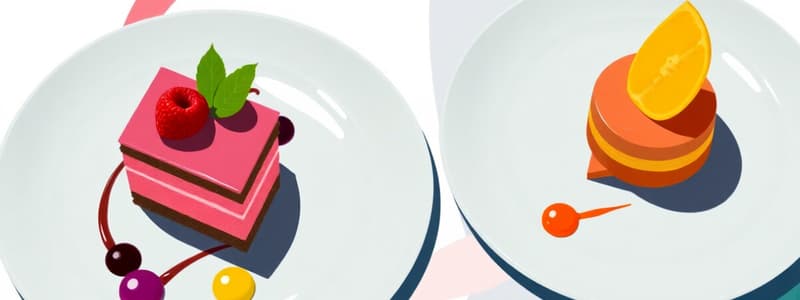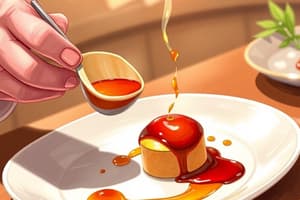Podcast
Questions and Answers
What is the primary focus of food presentation according to the content?
What is the primary focus of food presentation according to the content?
- Cost-effectiveness for restaurants
- Speed of service
- Creating a visually pleasing impression (correct)
- Complexity of the menu items
What are plated desserts characterized by?
What are plated desserts characterized by?
- Only being served in round plates
- Being simple and minimalistic
- Incorporating several components and resembling main meals (correct)
- Having no accompanying items
Which plate type is designed specifically for ice cream dishes?
Which plate type is designed specifically for ice cream dishes?
- Salad plate
- Charger plate
- Tulip sundae glass (correct)
- Soup bowl
What is a potential issue with using oversized plates for serving food?
What is a potential issue with using oversized plates for serving food?
What is often the chef's role in plate selection?
What is often the chef's role in plate selection?
Which of the following describes the typical shape of most plates?
Which of the following describes the typical shape of most plates?
Why is it important to not overcrowd plates when presenting food?
Why is it important to not overcrowd plates when presenting food?
What characteristic of plates varies and can affect presentation?
What characteristic of plates varies and can affect presentation?
What is the primary purpose of using white and cream colors in restaurant china?
What is the primary purpose of using white and cream colors in restaurant china?
Which combination is least likely to create visual appeal on a dessert plate?
Which combination is least likely to create visual appeal on a dessert plate?
What is a key point to consider when arranging desserts on a plate?
What is a key point to consider when arranging desserts on a plate?
Which aspect should be avoided when composing a dessert plate?
Which aspect should be avoided when composing a dessert plate?
What is meant by 'textures' in dessert preparation?
What is meant by 'textures' in dessert preparation?
What type of flavors should be limited to create a harmonious dessert?
What type of flavors should be limited to create a harmonious dessert?
Which element is NOT mentioned as important for visual interest in a dessert?
Which element is NOT mentioned as important for visual interest in a dessert?
What characteristic of colors should be considered when plating desserts?
What characteristic of colors should be considered when plating desserts?
What effect do garnishes have on a plated dessert?
What effect do garnishes have on a plated dessert?
When plating, what should always remain the focal point?
When plating, what should always remain the focal point?
Flashcards
Presentation
Presentation
The act of presenting food to diners in a visually appealing way, considering colors, textures, and shapes for a harmonious balance.
Plated Desserts
Plated Desserts
Desserts that combine multiple components and are presented on a plate like a main meal.
Choosing Plates
Choosing Plates
The choice of plates for serving desserts based on the size, shape, and style that best highlight the food.
Plate Shapes
Plate Shapes
Signup and view all the flashcards
Plate Size
Plate Size
Signup and view all the flashcards
Plate Depth
Plate Depth
Signup and view all the flashcards
Plate Rim
Plate Rim
Signup and view all the flashcards
Plate Size and Shape in Dessert Presentation
Plate Size and Shape in Dessert Presentation
Signup and view all the flashcards
Composition (Dessert Plate)
Composition (Dessert Plate)
Signup and view all the flashcards
Textural Contrast
Textural Contrast
Signup and view all the flashcards
Dessert Plate Colors
Dessert Plate Colors
Signup and view all the flashcards
Shapes in Dessert Presentation
Shapes in Dessert Presentation
Signup and view all the flashcards
Dessert Plate Flavors
Dessert Plate Flavors
Signup and view all the flashcards
Flavor Components in Dessert
Flavor Components in Dessert
Signup and view all the flashcards
Neutral Colors in Dessert Plates
Neutral Colors in Dessert Plates
Signup and view all the flashcards
Colored/Patterned Dessert Plates
Colored/Patterned Dessert Plates
Signup and view all the flashcards
Complementary Flavors in Dessert
Complementary Flavors in Dessert
Signup and view all the flashcards
Contrasting Flavors in Dessert
Contrasting Flavors in Dessert
Signup and view all the flashcards
Study Notes
Presenting Desserts
- Presentation is crucial; diners first visually assess food.
- Plates should harmonize colors, textures, and shapes.
- Plated desserts mirror main courses in presentation, balancing components.
- Plate selection, shape, size, and arrangement affect diner perception.
Choosing Plates
- Restaurant china, durable, comes in various shapes, colors, and styles.
- Chefs often select china based on the food served.
- Specific plates often cater to specific dishes (e.g., sundae glass for ice cream).
Plate Size and Shape
- Standard plate shapes are round, oval, rectangular, square, and triangle.
- Plate sizes range significantly, from small bread plates to large charger plates.
- Plates are typically concave, with variable depths.
- Plates often have rims, with different rim widths.
- Choose plates big enough without overcrowding food.
- Oversized plates can make food appear sparse.
Plate Colors and Patterns
- Plain white or cream-colored plates suit most foods.
- Colored and patterned plates can accent food when contrasting with colors.
- Food should be the focal point on the plate.
- Color and pattern should complement the food.
Composition and Shapes
- Design plates to entice diners, creating balanced compositions via careful arrangement.
- Use a variety of shapes for visual interest/drama.
- Height can be an effective addition, but consider diner's eating comfort.
Colors
- Use a variety of colors when appropriate; aim for balance and contrast.
- Add garnishes/additional ingredients for color if needed.
Textures
- Include diverse textures (e.g., crisp, crumbly, smooth, creamy).
- The textures should harmonize with each other and the flavor profiles.
Flavors
- Carefully combine flavors, limiting variety on a plate to avoid confusion.
- Use complementary or contrasting flavors.
- Layer similar flavors with varying intensities, creating thematic pairings.
Formulas for Garnishes
- The text provides references to different garnishing formulas scattered across other pages. (Includes examples of formulas like Basic Nougatine, Candied Almonds, etc.)
Studying That Suits You
Use AI to generate personalized quizzes and flashcards to suit your learning preferences.
Description
This quiz explores the essential aspects of presenting desserts effectively, including the importance of color, texture, and plate choice. It covers the influence of plate shapes, sizes, and colors on diners' perceptions. Ideal for culinary students and professionals looking to enhance their plating skills.




